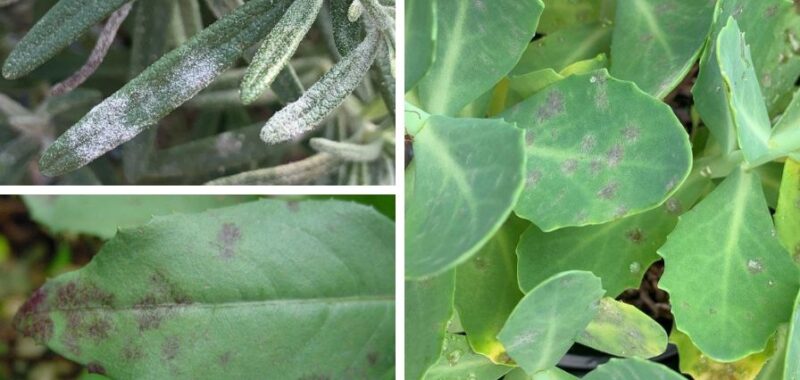
(Clockwise from top left) Typical white powdery fungal sporulation due to powdery mildew infection of rosemary, Powdery mildew infection of Sedum showing purple to gray patches, and Purplish spotting with little to no sporulation is powdery mildew infection of Fuchsia plants. | Jean WIlliams-Woodward, University of Georgia
In a recent e-Gro Alert, Jean Williams-Woodward of the University of Wyoming, and previously of the University of Georgia, covers why powdery mildew is appearing earlier in the season than expected due to erratic weather patterns and changes to climate, and what growers can do about that to keep their crops free from the common plant disease.
Why Is Powdery Mildew So Present This Time of Year?
Currently, much of the country is being affected by what Williams-Woodward refers to as “fake summer,” which results in “greenhouses heating up too much during the day followed by big temperature fluctuations at night.” This whiplash between temperatures, paired with high humidity levels, is a perfect hotbed for powdery mildew.
Powdery Mildew Symptom Variations
Powdery mildew is easily recognizable when its “white powdery fungal growth” is present on the leaves, stems, and flowers of an infected plant. However, there are certain conditions where this plant disease can be more difficult to spot.
First, its symptoms may be present on lower and/or shaded leaves that can be more easily missed. Additionally, certain climate and weather conditions can turn infected areas from the more common white discoloration to shades of “yellow or purplish patches” and cause little to no sporulation, which Williams-Woodward notes as having identified on Sedum and Fuchsia plants.
Scouting for Powdery Mildew and Responding Promptly
Williams-Woodward suggests that during the transitional periods of spring and fall, growers should scout for powdery mildew by first looking “on both the upper and lower sides of leaves for the white, powdery growth.” Additionally, special attention should be paid to “areas where temperature within the greenhouse may fluctuate more readily,” such as near doors and HVAC equipment.
Inflected plants should be addressed at once to reduce disease spread, either by removing infected tissue (leaves, stems, etc.) or the whole plant. Additionally, the disease “can potentially survive on closely related weed species,” so weeds around the greenhouses should be dealt with to eliminate a transmission vector.
For additional information on scouting for and treating powdery mildew, please read the full e-Gro (Electronic Grower Resources Online) alert “Powdery Mildew Is Out and About; Scout for It.” Additional and current e-Gro alert pieces from Volume 14 (2025) can be found online.
0
1
5
Why It’s Important to Start Scouting for Powdery Mildew Early

